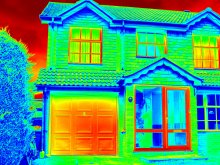What is a U-value?
A U-value is a measure of heat loss in a building element such as a wall, floor or
roof. It can also be referred to as an ‘overall heat transfer co-efficient’ and measures
how well parts of a building transfer heat. This means that the higher the U-value
the worse the thermal performance of the building envelope. A low U value usually
indicates high levels of insulation. They are useful as it is a way of predicting
the composite behaviour of an entire building element rather than relying on the
properties of individual materials.
U-values are important because they form the basis of any energy or carbon reduction
standard. In practice, nearly every external building element has to comply with
thermal standards that are expressed as a maximum U-value. Knowledge of how to simply
calculate U-values at an early stage in the design process, avoids expensive re-working
later on in a project. It allows the designer to test the feasibility of their project
at an early stage to ensure it is fit for purpose and will comply with regulatory
frameworks.







